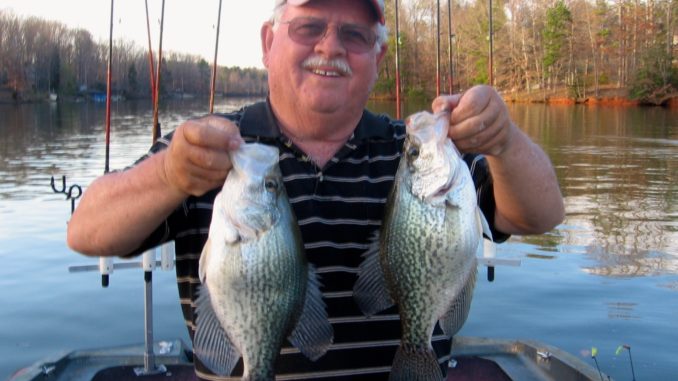
Long-line trolling, shooting docks and brush will put fish in the boat
Jerry Neeley of Jerry’s Fishing Guide Service uses a two-pronged attack to catch staging crappie at Lake Wylie this month.
“I catch crappie two different ways once the water temperature reaches the 50s,” Neeley said. “One way is long-line fishing; some call it flat-line fishing, but they’re both the same thing.”
For long-line fishing, Neeley (www.carolinasfishing.com) sets out 10 to 12 rods in 10- to 12-foot lengths carrying 1/16-ounce jigs in six to eight colors tied to 6-pound line. He lets each line out 40 to 60 feet behind the boat to sample various depths. Occasionally, he tips his jigs with minnows.
Neeley pulls the baits at the mouths of creeks and continues all the way to the creek backs, following the bank or moving down the middle of the creek. Either way, his trolling path never follows a straight line.
“I zig-zag when I troll to impart more erratic action to the jigs,” he said. “I vary my rate of speed to fish different depths.”
If Neeley marks crappie in 12 to 15 feet of water, he trolls at .9 mph; if the fish are suspended about 4 or 5 feet beneath the surface, he trolls at 1.1 mph to make his jigs rise.
When he catches a fish, he notes the boat’s speed, the fish’s depth and the jig color and then makes adjustments with his gear to duplicate how he caught the first fish.
“I’m always adjusting jig colors and trolling speeds until the fish tell me what color and what speed they prefer,” Neeley said.
His favorite jig colors include chartreuse/black, chartreuse/yellow, John Deere green, yellow/green, green, chartreuse, and yellow.
“I catch the most crappie with chartreuse-and-something combos,” said Neeley, who does most of his fishing in Mill, Crowder and Big Allison creeks.
If long-line fishing isn’t productive, he employs his second strategy, casting or shooting brush-laden docks or probing brush in 3 to 4 feet of water.
For fishing docks, he uses light spinning gear spooled with 4-pound test line, using jigs in red/white or red/white/yellow. His casts probe every nook and cranny of a dock.
He fishes shallow brush with a small popping cork and jig.
“Toss the cork over the brush, and give the cork a couple of pops,” Neeley said. “If the cork turns on its side, a fish is on. A big crappie will take the cork completely under.”
On cloudy days, Neeley said crappie scatter, so he trolls to cover more water; on sunny days, the fish bunch up, so he hits the docks and shallow brush.



Be the first to comment